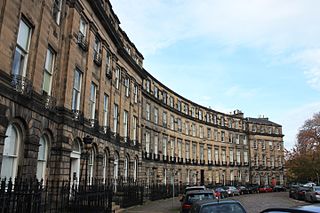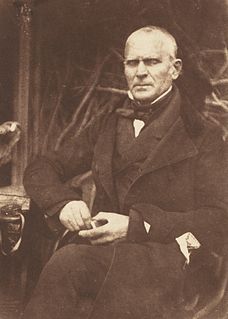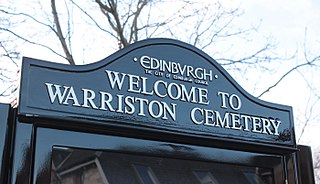
The Dean Cemetery is a historically important Victorian cemetery north of the Dean Village, west of Edinburgh city centre, in Scotland. It lies between Queensferry Road and the Water of Leith, bounded on its east side by Dean Path and on its west by the Dean Gallery. A 20th-century extension lies detached from the main cemetery to the north of Ravelston Terrace. The main cemetery is accessible through the main gate on its east side, through a "grace and favour" access door from the grounds of Dean Gallery and from Ravelston Terrace. The modern extension is only accessible at the junction of Dean Path and Queensferry Road.

John Hutton Balfour was a Scottish botanist. Balfour became a Professor of Botany, first at the University of Glasgow in 1841, moving to the University of Edinburgh and also becoming the 7th Regius Keeper of the Royal Botanic Garden Edinburgh and Her Majesty's Botanist in 1845. He held these posts until his retirement in 1879. He was nicknamed Woody Fibre.

Adam Black was a Scottish publisher and politician. He founded the A & C Black publishing company, and published the 7th, 8th and 9th editions of the Encyclopædia Britannica.

Sir James Balfour Paul was the Lord Lyon King of Arms, the officer responsible for heraldry in Scotland, from 1890 until the end of 1926.

Sir Isaac Bayley Balfour, KBE, FRS, FRSE was a Scottish botanist. He was Regius Professor of Botany at the University of Glasgow from 1879 to 1885, Sherardian Professor of Botany at the University of Oxford from 1884 to 1888, and Professor of Botany at the University of Edinburgh from 1888 to 1922.

Edward Francis Maitland, Lord Barcaple (1803–1870) was a Scottish advocate and judge and Senator of the College of Justice.

William Ramsay McNab was a Scottish physician and botanist.

Dr Robert Kaye Greville FRSE FLS LLD was an English mycologist, bryologist, and botanist. He was an accomplished artist and illustrator of natural history. In addition to art and science he was interested in causes like abolitionism, capital punishment, keeping Sunday special and the temperance movement. He has a mountain in Queensland named after him.

James Edward Tierney Aitchison MD LLD CIE was a Scottish surgeon and botanist. He worked as British Commissioner to Ladakh, India in 1872 and collected numerous specimens from the region and published catalogues of plants including those of economic interest. The plant genus Aitchisonia was named after him by Helmsley but the name is no longer in use. In authorship he is normally known as J. E. T. Aitchison.

Warriston Cemetery is a cemetery in Edinburgh. It lies in Warriston, one of the northern suburbs of Edinburgh, Scotland. It was built by the then newly-formed Edinburgh Cemetery Company, and occupies around 14 acres (5.7 ha) of land on a slightly sloping site. It contains many tens of thousands of graves, including notable Victorian and Edwardian figures, the most eminent being the physician Sir James Young Simpson.
The Botanical Society of Scotland (BSS) is the national learned society for botanists of Scotland. The Society's aims are to advance knowledge and appreciation of flowering and cryptogamic plants, algae and fungi. The Society's activities include lectures, symposia, field excursions, field projects and an annual Scottish Botanist's Conference, held jointly with the Botanical Society of Britain and Ireland for exchange of information between botanists working in different areas. Its publications include a twice-yearly newsletter, BSS News, and a scientific journal, Plant Ecology & Diversity. The society is closely linked to the Royal Botanic Garden Edinburgh and the Scottish universities.

Henry Snell Gamley (1865–1928) was a Scottish sculptor specialising in war memorials and sculpture on tombs. He was however also responsible for other figurative sculpture on prominent Edinburgh buildings such as the Usher Hall and works at Holyrood Palace.
William Grant Craib was a British botanist. Craib was Regius Professor of Botany at Aberdeen University and later worked at the Royal Botanic Gardens, Kew.

Thomas Jackson Crawford (1812–1875) was a Scottish minister and professor of divinity at the University of Edinburgh. He served as Moderator of the General Assembly of the Church of Scotland in 1867, the highest level within the Scottish church.
Andrew Peebles Aitken FRSE FBSE (1843-1904) was a Scottish agricultural chemist remembered primarily for his research into fertiliser response times. He laid the foundations of modern understanding of increased crop yields through the use of artificial fertilisers.
Dr William Lauder Lindsay FRSE FLS LRCS was a Scottish physician and botanist. As a physician he largely worked in the field of mental health. As a botanist he specialised in lichens.
Dr William Seller FRSE PRCPE was a Scottish physician and botanist. From 1848 to 1850 he was President of the Royal College of Physicians of Edinburgh.
George Ann Panton FRSE (1842–1903) was a 19th-century Scottish merchant and noted amateur botanist and geologist. In later life he was an actuary by trade with links to Birmingham.
George Swinton FRSE (1780–1854) was a Scottish civil servant who served as Chief Secretary to the British government during their colonial rule of India. During this time he was also a noted botanist.
Patrick Neill Fraser FRSE FRSGS (1830–1905) was a Scottish printer and botanist. He was an expert on ferns.













